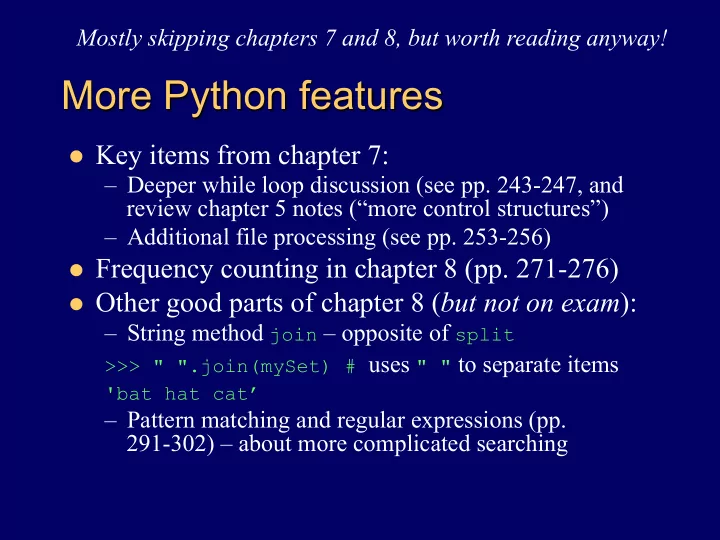

Mostly skipping chapters 7 and 8, but worth reading anyway! More Python features l Key items from chapter 7: – Deeper while loop discussion (see pp. 243-247, and review chapter 5 notes (“more control structures”) – Additional file processing (see pp. 253-256) l Frequency counting in chapter 8 (pp. 271-276) l Other good parts of chapter 8 ( but not on exam ): – String method join – opposite of split >>> " ".join(mySet) # uses " " to separate items 'bat hat cat’ – Pattern matching and regular expressions (pp. 291-302) – about more complicated searching
Starting chapter 9 (just covering through p. 315 though) Recursive functions l Definition: functions that call themselves, directly or indirectly l But proper recursive functions also stop! def factorial(n): # return n! = n(n-1)(n-2)…1 if n > 1: # recursive step: call self for n-1 return n * factorial(n-1) return 1 # base case: stop recursion if n < 2 – Must have (at least) one base case, and the recursive step must converge on a base case l Otherwise “ infinite recursion ” l See/try first two functions in .../demos/ recursive.py
Recursive drawing examples l Listing 9.2 (also in recursive.py) – uses drawSquare function from chapter 2 def nestedBox(aTurtle,side): if side >= 1: # recursive step drawSquare(aTurtle,side) # A nestedBox(aTurtle,side-5) # B # base case: do nothing (side too small to draw) – Note: switch lines A and B – will draw smallest first l Draw tick marks on a ruler (recursive.py again) l Listing 9.4 – draw nested triangles – Note demo introduces command line argument too l Listing 9.3 (and exercises 9.11-9.13) – draw tree
Introducing chapter 10 (won’t be on exam) OOP and Python classes l Essence of object-oriented programming: – An object is an instance of a class – The class defines what data an object knows, and what operations an object can carry out l Instance data – what an object knows: its state l Methods – what an object can do l Objects of Python’s class Turtle for example: – Instance data include color, heading, position – Methods include forward, backward, penup
Example: class Planet l In Python – a class’s constructor defines what an object of the class will know class Planet: def __init__(self, iname, irad, im, idist): self.name = iname self.radius = irad self.mass = im self.distance = idist ... l A Planet object will know its own name, radius, mass, and distance from the sun
Constructing a Planet object l Creating an object invokes the constructor >>> myplanet = Planet('X25’,45,198,1000) myplanet Methods name radius __init__ mass distance __init_ _ def State X25 198 45 1000
Adding some Planet methods l Accessor methods to access the data values def getName(self): return self.name – Also getRadius , getMass , getDistance l Mutator methods to change the data values def setName(self, newname): self.name = newname – Also setRadius , setMass , setDistance l Special method for converting Python object to str def __str__(self): return self.name class Planet
A more complete Planet object getVolume getSurfaceArea _ _str__def def def _ _init__def getDensity getVolume __ str _ _ def getSurfaceArea myhome __ init _ _ Methods getName getDensity def name radius getName mass distance getRadius State getMass Earth getDistance getRadius def 5.97e24 6371 getMass def getDistance 152097701 def
OOP example: Modeling a solar system Animated solar system - Planet, Sun and SolarSystem classes, plus a function to create and animate the parts
Recommend
More recommend